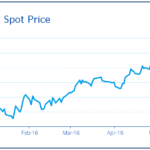Oil price increase: Reality or pipe dream?
Do you remember when oil prices fell below $30 per barrel? Back in February, markets couldn’t see the light at the end of the tunnel as prices hit their lowest level since December 2013. But in a gravity defying twist, prices rebounded to $52 per barrel in early June and have stabilized at an average of $50 per barrel since then.

Let’s look at the driving forces behind this increase. For one, there has been a reduction in the supply of oil from countries where production costs exceed current prices.as This adjustment has been particularly strong in the U.S., where production has declined by around one million barrels per day over the last year. High-cost projects have become financially unviable, investments in oil and gas have plummeted, and thousands of workers have lost their jobs.
A second force is the weakening of the U.S. dollar. At the start of the year, expectations of higher interest rates and a slowdown in emerging economies strengthened the U.S. dollar. However, after markets reassessed expectations on global economic growth and the path of monetary policy in the U.S., the dollar began to weaken. Since crude is traded in dollars, a more affordable greenback allows net importers to buy more with less.
Third, although economic growth has slowed around the world, demand for petroleum products has been particularly strong in the U.S. and China, where auto sales have surged. In China, the stronger demand for refined products like gasoline has helped to offset the lower demand for petroleum products from a weaker industrial sector. Meanwhile, robust economic growth in India is also leading demand for petroleum products.
And last but not least, political and economic events have disrupted production in Libya, Nigeria and Venezuela, while weather and natural disasters are to blame for significant production cuts in Iraq and Canada. Combined together, these four elements have driven the increase in crude prices since early in the year.
Together, these four elements have driven the increase in crude prices since early in the year.
The question remains: is this rally here to stay? We project that prices will go up steadily, most likely above $50 per barrel by the end of this year. Crude output in countries with high production costs, such as the U.S., Canada, Brazil and Colombia, will continue to adjust throughout the year. Meanwhile, the trend of petroleum demand is likely to remain stable supported by ongoing economic growth. Nevertheless, a series of elements could limit the upside in prices: the extremely high level of crude inventories, the transitory nature of supply disruptions, and the possibility of a rapid rebound in U.S. production as shale operators find the current level of prices less oppressive (the active rig count has increased for three consecutive weeks since the end of May).
Moreover, the aftershocks of Brexit could also generate periods of elevated uncertainty and limit the upside in prices. After the results of the referendum were announced, prices reverted back to mid-June levels when markets had assessed a more uncertain economic environment and the expectation of a rebound in U.S. crude oil production. Although prices have experienced a significant adjustment, they remain well above their last bottom in January and the bottom reached during the Great Recession. The magnitude of the price decline brought on by Brexit is uncertain. In the short-term, Brexit could continue to affect oil prices through its impact on the exchange rate and global demand. If the dollar continues to appreciate relative to the pound and other currencies, oil prices may decline further. After the Brexit vote, the USD Index rose 2%, but remains well below its peak from last December. Likewise, slower global growth would mean weaker energy demand and thus downward pressures on oil prices. However, if the effects of Brexit are short-lived, oil prices could bounce back somewhat.

All in all, at the current levels, oil prices do not seem to present a threat to the global economy. On the contrary, they may have actually reached a sweet spot in which producers can breathe again and consumers can still enjoy relatively affordable fuel prices.
Follow BBVA Research U.S.A on Twitter at @bbvaresearchusa.
Any statement or opinion of a BBVA Compass economist is that economist’s own statement or opinion and does not represent a statement or prediction by BBVA Compass, its parent companies or management.